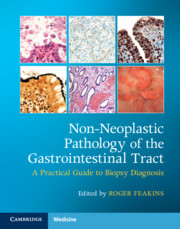Book contents
- Non-Neoplastic Pathology of the Gastrointestinal Tract
- Non-Neoplastic Pathology of the Gastrointestinal Tract
- Copyright page
- Dedication
- Contents
- Preface
- Acknowledgements
- Contributors
- Chapter 1 The Value of Gastrointestinal Biopsy
- Chapter 2 Gastrointestinal Involvement by Systemic Disease
- Chapter 3 Radiation and the Gastrointestinal Tract
- Chapter 4 Transplantation, Immunodeficiency, and Immunosuppression
- Chapter 5 Drug-Induced Gastrointestinal Disease
- Chapter 6 Gastrointestinal Ischemia and Vascular Disorders
- Chapter 7 Paediatric Conditions
- Chapter 8 Gastrointestinal Dysplasia
- Chapter 9 Normal Oesophageal, Gastric and Duodenal Mucosa
- Chapter 10 Histology of Gastroesophageal Reflux Disease and Barrett’s Oesophagus
- Chapter 11 Infections of the Oesophagus and Rare Forms of Oesophagitis
- Chapter 12 Assessment of Gastric Biopsies
- Chapter 13 Types of Gastritis
- Chapter 14 Duodenitis
- Chapter 15 Coeliac Disease
- Chapter 16 Inflammatory Bowel Disease and the Upper Gastrointestinal Tract
- Chapter 17 Normal Lower Gastrointestinal Mucosa
- Chapter 18 Infectious Disorders of the Lower Gastrointestinal Tract
- Chapter 19 Jejunitis and Ileitis
- Chapter 20 Microscopic Colitis
- Chapter 21 Inflammatory Bowel Disease Diagnosis
- Chapter 22 Mimics of Inflammatory Bowel Disease
- Chapter 23 Complications of Inflammatory Bowel Disease
- Chapter 24 Approach to Reporting Inflammatory Bowel Disease Biopsies
- Chapter 25 Ileal Pouch Anal Anastomosis
- Chapter 26 Diverticular Disease, Mucosal Prolapse, and Related Conditions
- Chapter 27 Non-Neoplastic Diseases of the Anal Canal
- Index
- References
Chapter 19 - Jejunitis and Ileitis
Published online by Cambridge University Press: 06 June 2020
- Non-Neoplastic Pathology of the Gastrointestinal Tract
- Non-Neoplastic Pathology of the Gastrointestinal Tract
- Copyright page
- Dedication
- Contents
- Preface
- Acknowledgements
- Contributors
- Chapter 1 The Value of Gastrointestinal Biopsy
- Chapter 2 Gastrointestinal Involvement by Systemic Disease
- Chapter 3 Radiation and the Gastrointestinal Tract
- Chapter 4 Transplantation, Immunodeficiency, and Immunosuppression
- Chapter 5 Drug-Induced Gastrointestinal Disease
- Chapter 6 Gastrointestinal Ischemia and Vascular Disorders
- Chapter 7 Paediatric Conditions
- Chapter 8 Gastrointestinal Dysplasia
- Chapter 9 Normal Oesophageal, Gastric and Duodenal Mucosa
- Chapter 10 Histology of Gastroesophageal Reflux Disease and Barrett’s Oesophagus
- Chapter 11 Infections of the Oesophagus and Rare Forms of Oesophagitis
- Chapter 12 Assessment of Gastric Biopsies
- Chapter 13 Types of Gastritis
- Chapter 14 Duodenitis
- Chapter 15 Coeliac Disease
- Chapter 16 Inflammatory Bowel Disease and the Upper Gastrointestinal Tract
- Chapter 17 Normal Lower Gastrointestinal Mucosa
- Chapter 18 Infectious Disorders of the Lower Gastrointestinal Tract
- Chapter 19 Jejunitis and Ileitis
- Chapter 20 Microscopic Colitis
- Chapter 21 Inflammatory Bowel Disease Diagnosis
- Chapter 22 Mimics of Inflammatory Bowel Disease
- Chapter 23 Complications of Inflammatory Bowel Disease
- Chapter 24 Approach to Reporting Inflammatory Bowel Disease Biopsies
- Chapter 25 Ileal Pouch Anal Anastomosis
- Chapter 26 Diverticular Disease, Mucosal Prolapse, and Related Conditions
- Chapter 27 Non-Neoplastic Diseases of the Anal Canal
- Index
- References
Summary
Infectious diseases of the lower gastrointestinal tract are caused by a vast array of viral, bacterial, fungal, and parasitic organisms. Pathologists are often called upon to distinguish infectious enterocolitis from other inflammatory disorders and, when possible, identify the causative pathogen or group of pathogens. Thus, pathologists should be aware of the patterns of injury and morphologic features that suggest infectious enterocolitides and should be able to generate a reasonable but narrow differential diagnosis that guides clinical management. This chapter reviews the clinical, gross, and, microscopic features of common and emerging infectious diseases of the lower gastrointestinal tract and emphasizes the pathologic findings that aid the appropriate classification of these diseases in daily practice.
- Type
- Chapter
- Information
- Non-Neoplastic Pathology of the Gastrointestinal TractA Practical Guide to Biopsy Diagnosis, pp. 287 - 309Publisher: Cambridge University PressPrint publication year: 2020

